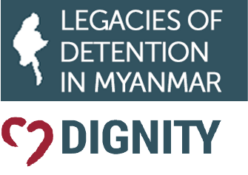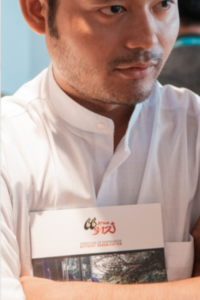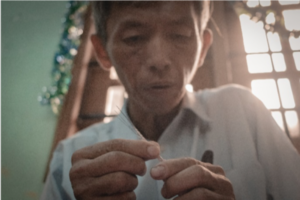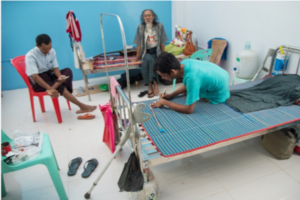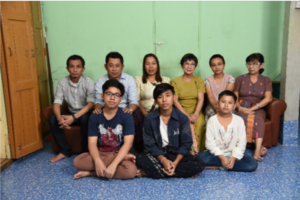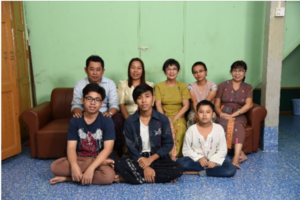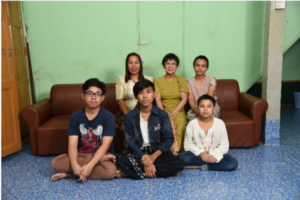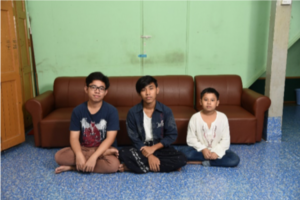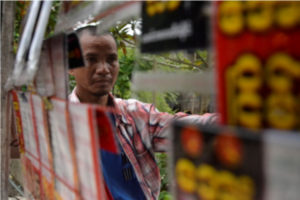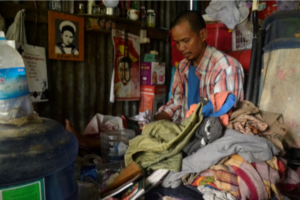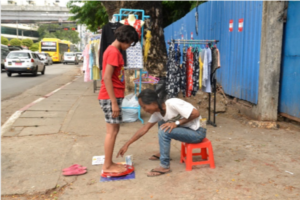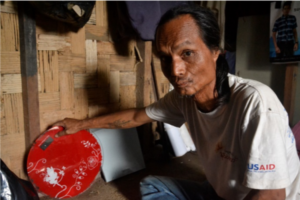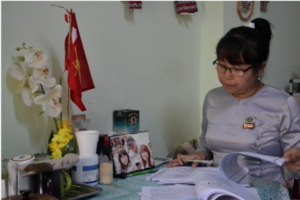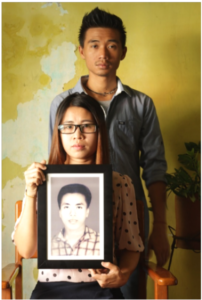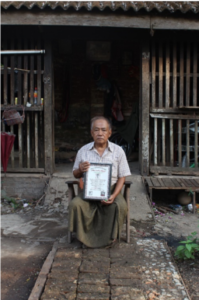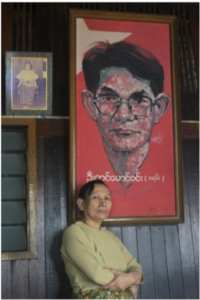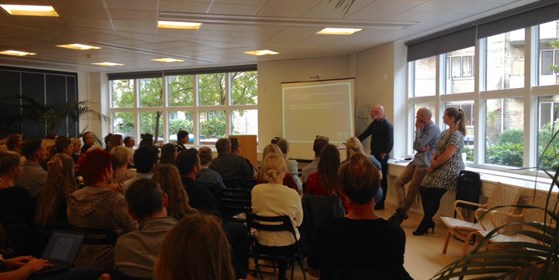Forfatter: Rasmu
How do we study prisons when they are relatively inaccessible and out of our reach? […]
… And how do researchers balance scientific curiosity, self-doubt and moral repugnance when engaging with punitive practices of imprisonment.
For some answers to these question please see Liv S. Gaborit’s recent article ‘Looking through the Prison Gate’, Tomas Max Martin’s discussion of Kafka and qualms, and Andrew M. Jefferson’s meditation on his desire to know and not know what goes on behind the walls.
‘We are Like Water in Their Hands’ – PhD project completed.
Beyond the Prison Gate – Recognition through Photography and Action Research in Myanmar
Prisoners’ Contact with the Outside World
Rioting for Rule of Law – Prison Amnesties and Riots in Myanmar
Disseminating Knowledge: Brief report on simultaneous events in Canberra and Copenhagen
The 15th March 2019 was quite a day for the Legacies of Detention project. Simultaneously across two hemispheres key events were taking place that demonstrate some of the achievements of the project so far. In Copenhagen PhD fellow Liv Gaborit together with former political prisoner Leytar Tun launched an exhibition of photographs taken by a group of former prisoners (Letyar Tun, Sai Minn Thein, Pho Nyi Htwe and Phyoe Dhana Chit Lynn Htike) in Yangon reflecting the contemporary struggles they and their families face. The photos, which have also been displayed in Myanmar, are the product of an action research component of Liv’s doctoral research that focuses on experiences of imprisonment with a focus on recognition. From Liv’s perspective and that of the Legacies team in Denmark, the exhibition itself serves as a gesture of recognition of the hardships and sufferings of the many people who participated (and still do) in the struggle towards democracy and justice in Myanmar. It is also a sign of what is possible today by way of co-production of knowledge given the right combination of tenacity, courage and willingness to become ethnographically embedded that is necessary to build the right kind of relationships to follow through on such an endeavour.
On the same day over 16000 km away our local project partners, Justice for All Law Firm, presented at one of the most prestigious academic conferences on Myanmar, the Myanmar Update conference held at the Australian National University’s Myanmar Research Centre. On behalf of the research team (U Than Htaik, Kyaw Lin Naing, Nwe Ni Aung and Aung Lin Oo), Kyaw Lin Naing presented the results of a qualitative case study conducted on the topic of Prisoners’ Contact With the Outside World. The presentation featured a description of the case study methodology, the significance of the topic and a synthesis of the findings. In brief the case study confirms the way in which contact with the outside world is important to prisoners to sustain them physically and emotionally and documents the variety of forms such contact takes across different types of detention facility. The study also illuminates the great lengths family members go to, to ensure contact and the hindrances they have often faced. The conference was a fantastic opportunity to disseminate this recently generated knowledge. This was the team’s first experience of participating in such a conference and the first opportunity to expose an audience of scholars from and beyond Myanmar to the research methods applied and the findings. In addition, Principal Investigator Andrew M. Jefferson presented at the conference based on data collected from a series of interviews with ex-prisoners now occupying positions of political authority. Jefferson argued that the various disruptions that feature in the lives of the former political prisoners should be understood as links in life trajectories rather than breaks, an argument that might reasonably be extended to the way we think of the ongoing sociopolitical transition in Myanmar.
So, from the project’s point of view there is cause for celebration and we hope the reader might identify with our sense of achievement. And yet at the same time as we cautiously register some achievements we are conscious of the bigger socio-political picture that frames the two events we report on here: Myanmar is still in flux; freedom of speech is still limited; gross human rights violations continue; the peace process has stalled; political authority is highly centralized; substantial political power remains in the hands of the military; dreams of a unified federal state are not shared by all and seem out of reach; and while the positively-oriented recalibration of the relationship between state and citizen one might associate with a shift towards a consolidating democracy can be sensed in certain quarters there remains a long way to go before the anticipated fruits of the changing political dispensation are available and accessible to all.
The photo exhibition will be exhibited at Kulturhuset Indre By at least until June 1. Click here to read more about the exhibition in an article written by Globalnyt (in Danish).
From the Field: Vipassana – Looking Inwards to Understand Experiences of Imprisonment in Myanmar

By: Liv Stoltze Gaborit
Published first at the blog: Bordercriminologies, Oxford University
Since October of 2016 I have been living in Myanmar doing fieldwork for my PhD on experiences of imprisonment. This particular fieldwork experience is different for me, as it is the first time I am doing prison research without access to the prisons themselves. Developments in the country over the past few years have opened a political space in which prison research is possible, though access to penal institutions is still difficult to attain. We expect that our long term engagement in Myanmar via our project Legacies of Detention in Myanmar, will open these sites to researchers in the future. For now, however, I am working from the outside with several organized groups of former political prisoners (e.g., Assistance Association for Political Prisoners and Former Political Prisoners Society) and other NGOs that engage with former prisoners.
One of the organisations engaging directly with the prisons is a local meditation centre in Yangon practising the tradition of Vipassana. This centre coordinates 10-day Vipassana retreats for prisoners inside the notorious Insein Prison in Yangon. Several of the former prisoners I have talked to have participated in these retreats and still come to the meditation centre, following their release. I engaged with the centre and talked to some of the teachers to get to know more about their work with prisoners. Although the teachers willingly told me about their courses, they emphasised that the only way to understand Vipassana was through first-hand experience. After some consideration, I decided to join a retreat at the meditation centre myself.
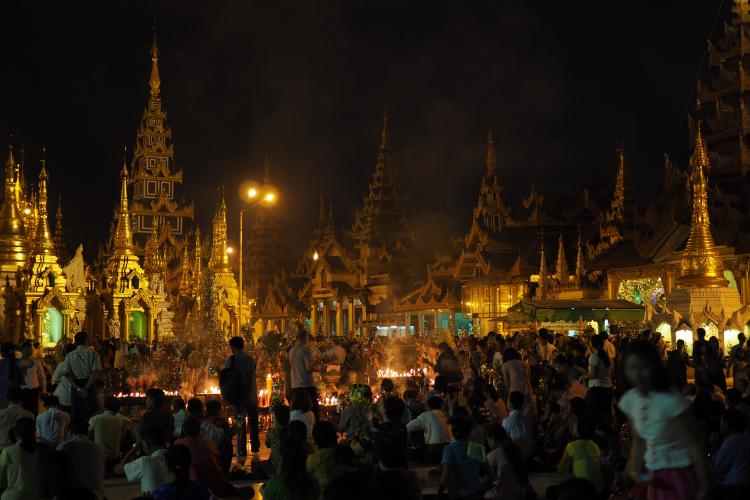
Evening prayers at Shwedagon Pagoda (Photo: Liv Gaborit)
Personally, I have some experience with meditation and have been on two similar retreats before, though none as restrictive as this one. However, considering my past experiences, I felt relatively comfortable that I would be able to stick to this stricter regime, which demanded rising at 4am, meditating for more than 10 hours a day, and staying in silence for 9 of the 10 days. My main frustration as a researcher, was that the regime did not allow writing, so I was unable to record field notes in situ.
For the first couple of days, my thoughts focused on how the experience was useful for my work. I considered the differences and similarities of my voluntary confinement within the compound of the meditation centre to the confinement experienced by prisoners. I thought about how this situation – which for me was full of deprivations – from talking, writing, eating meat and moving outside the compound – might be an experience of increased privileges for many prisoners – better food, more space, and freedom from working and attending to other people’s needs.
The first three days we did Samadhi meditations to prepare our concentration for what would come next. As expected, my mind wandered. During the first couple of days, as my thoughts wandered, I mentally drafted this blogpost and began to reflect on the interviews I had already conducted with former political prisoners. During the subsequent couple of days, I forgot this mental draft altogether as I couldn’t write it down. Slowly, thoughts about work subsided and I could focus on my experience in that particular moment. As I did, my role as tool for the research changed. Before, when I approached the field as a curious newcomer, I would use myself as a tool by being conscious of body language, adapting to local customs, when sometimes sharing carefully selected personal experiences or knowledge from previous work and when I recorded down my emotional reactions in fieldnotes. I did all these things to encourage trust building and enhance my understanding of the people I talked to. Now, I was not only a tool for the research by performing the role of the ethnographer, I was looking inwards to experience – on my own mind and body – what prisoners go through when they attend the Vipassana retreat inside prison. My position changed, from being a curious newcomer before the retreat, to a full participant during the retreat, and finally, after the retreat, to a newcomer with an improved understanding of the field in which I was engaged. And so, the emphasis as participant and observer dynamically fluctuated as I did participant observation.
The main technique used in this kind of Vipassana utilizes continuous and repeated bodyscans. As I scanned through my body, tensions, memories, and feelings came to mind. One by one I lived through them and let them go. I spent seven of the ten days struggling with a psychosomatic pain in my left shoulder. Every time I sat down for meditation, the pain arose, every time the bell rang, it evaporated. Finally, when the teacher asked if I was facing any challenges, I managed to say I was struggling with pain in my shoulder. As the sentence left my lips, I began to cry. The teacher told me to keep trying and I would succeed – which was her answer to most questions – and otherwise she did not dwell on this pain. It felt strange to me, not to engage in a conversation about it and to only receive this somewhat distant support. I would have to face the pain myself. I was unable to stop the tears from falling, so as I sat down for meditation again I was still crying. I sat there curled up with my arms around my knees crying silently for around an hour before the feelings of sadness subsided, and I was able to start meditating again. When I did, the tension in my shoulder disappeared together with the pain.
I have experienced strong emotions in connection with fieldwork before, but they have always been a reaction to the encounter with the field. This was the first time fieldwork caused such strong emotions to arise based on introspection alone. These feelings were not connected to encounters in the field, the tragic situation of some of the people I had talked to, or the traumatic experiences they had gone through. These emotions were result of my own personal experiences long before I went on fieldwork. Through systematic introspection, I had brought my inner self into my fieldwork to a much larger extent than ever before.
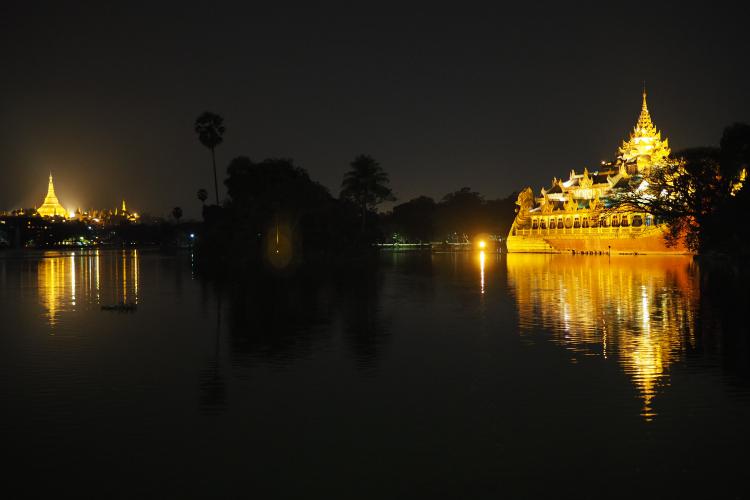
Shwedagon Pagoda seen from Kandawgyi – a strong reminder of the role of Buddhism in Burmese culture, visible from most places in Yangon (Photo: Liv Gaborit)
How is this personal experience of vulnerability relevant for my research? My inner world is not the place to look for truths about experiences of imprisonment in Myanmar. By doing this retreat however, I reached a new level of understanding of what former prisoners had already told me. I began to see more nuances in what I had read and heard about meditation in the prisons here. Rather than finding answers, I left the retreat with my mind full of new and more qualified questions about the experiences of imprisonment. New questions were raised about how some find comfort and strength in the solitude of solitary confinement while others feel the strain of it. Questions about the role of Buddhism for experiences of imprisonment; about experiences of the self and others; about perceptions of other prisoners and prison guards; the list goes on.
I had tried to reach an understanding of the role of meditation in prisons by talking with former prisoners about how they practiced it and how it helped them. I had talked to teachers and read research and the philosophy behind Vipassana meditation taught inside the prisons. But my level of understanding reached a new depth as I engaged myself in the same experience. While everyone goes through unique experiences in Vipassana, as well as in prison, having lived through the retreat I was offered a new and invaluable vantage point from which to understand the experiences that prisoners may have gone through.
Speaking with ex-detainees in Myanmar
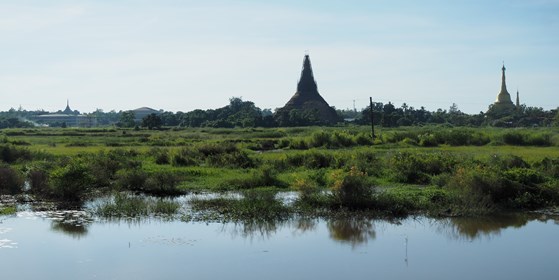
PhD-student Liv Stoltze Gaborit writes from Myanmar, where she is currently researching experiences of imprisonment through interviews with ex-detainees.
By Liv Stoltze Gaborit.
Photo: Liv Stoltze Gaborit, all rights reserved.
When I first moved to Yangon this October I started a three weeks’ intensive language course. Before noon I went to language class, after noon I met with stakeholders in the project, by evening I passed out, my head feeling like it was going to explode from all the new things I had to learn.
I finished the language class and the day after I passed the exam I flew to Kachin in northern Myanmar, where ethnic armed groups are still present and in conflict with the Burmese army. Up there it was not well seen that I tried to use my Burmese, since some saw it as the language of the state they are fighting, so I was back to struggling to learn to say hello and thank you in yet another language and otherwise getting by with interpreter and English.
I am now back in Yangon, trying with a private tutor to fully grasp the Burmese language. New tutor means a new way to spell most words, since the real spelling is in their own alphabet and there is no standardized Romanization. Language is a struggle, but I see progress and hope that after this course I will be able to have actual conversations and follow at least part of the answers in my interviews.
The resilience of detainees
It is fascinating to hear about the different ways that people survive inside prisons, and see the variety of feelings in our conversations about prisons. One moment we can be talking about the humiliation of living in a cell with no toilet where you would be sleeping in your own excrement, humiliated and plagued by skin diseases and maggots, the next their face light up as they tell me how they were still able to resist this system in some small way.
One former prisoner told me how he and his cell mates built an oven out of metal plates and burned plastic from their trash to light it. The smoke of burned plastic didn’t alarm the guards either (my guess is I have to prepare myself for some pretty smelly prisons if I gain access to the prisons). When they were done using the oven they had to dig a hole in the cell floor and hide it – they were happy they had a cell with plain dirt floor, not cement like some of the other cells.
Another striking moment was less happy. During an interview, the woman I was talking with began to tear up. The interview was conducted through interpreter, and until then she had faced him when she spoke and me when she listened to me or him. All of a sudden she turned her face at me and said the simple sentence “I remember” and then she began to cry. She was still feeling guilty because her friend had been imprisoned based on some of the evidence the police found when they searched her room. After the friend was imprisoned they shared a cell, and every time she saw her friend struggling or heard of her friends’ family struggling to get by outside, she felt it was her fault.
Death penalty at the age of 16
One of the men I talked to had been sentenced to death for high treason when he was only 16 years old because he was part of the student groups against the military regime back in ‘88. After one year and nine months his sentence was changed to 20 years of imprisonment, because it was illegal to give the death penalty to someone so young. He was released after 18 years – so at release he had spent more than half of his life in prison. Still, he had managed to get married and find a good job and accomplish a lot in his career and in his continued political effort. He told me that he was one of the lucky ones – because he had now reached a stage where he could try to be happy, most people in similar situations couldn’t.
These are the personal experiences that make up the history of Myanmar. I am truly thankful to the people who share such painful stories with me and join me in the effort to get a deeper understanding of what has happened and is happening in Myanmar prisons.
Change the system – not just the people

First impressions of Myanmar
By Tomas Max Martin, Researcher, 21 December 2016.
Picture by Liv Stoltze Gaborit, all rights reserved.
In November the DIGNITY Legacies of Detention team – Liv S. Gaborit, Andrew M. Jefferson and I – met in Yangon to take the partnerships with our Myanmar colleagues to the next level and to strengthen relations with the key stakeholders of the project.
Our meetings and interactions with Justice for All (JFA) – the small but energetic and committed law firm that is one of the main partners of the project – were very encouraging. First of all, we found ourselves in the company of a group of friendly, motivated and experienced legal analysts and activists, who will be our close colleagues for the coming years. Ideas were tested, questions asked and decisions made over coffee and green tea in JFA’s cozy office. Practicalities and administrative elements of the cooperation was firmed up. Many issues are still pending, but important steps were taken, not least the formulation and announcement of job adverts for researchers and assistants. Our substantive discussions about capacity development needs and concrete directions of the project led to a number of initial activities: JFA and Liv will for instance engage in a series of research method workshops on observation and fields notes, and we will jointly develop a pilot case study with a multi-disciplinary and empirical analysis of “prisoners’ contact with the outside world in Myanmar”. Thanks to the competent facilitation by JFA, our joint discussions culminated in a launch seminar with invited members of Myanmar civil society and academia. At the seminar we presented the main ideas of the project and engaged in a lively discussion on issues like the prison law, academic freedom, and the notion of political prisoners. Our powerpoint presentation from the seminar can be found here.
The Faculty of Law at Yangon University is the other main partner of the project. Again we were welcomed by interested colleagues, who took time to engage in frank discussions with us about the directions of a future partnership. We jointly drew up a clear outline of the activities that we want to pursue together – including PhD scholarships and library development – and discussed different options for the administrative set-up of the cooperation. We were also invited to give a lecture for the law students on “international perspectives on researching criminal justice systems”. We introduced a social scientific understanding of systems and change and our teaching took off from the basic idea that systems are constituted by institutions, rules and people. By looking at one particular institution – the prison; one important set of rules – human rights; and a key actor – the prisoner, we suggested that a locally grounded understanding of systemic change in the justice sector could be teased out. Our personal, problematizing and empirical approach was probably a bit unusual for the law students, but the reception of our talk was good and the debate was lively: Can we risk to improve prisons so much that punishment does not deter crime? Is prisoners’ right to vote a human right? And so on. Our powerpoint presentation from the lecture can be found here.
Alongside the close interactions with the project partners, we met and (re-)introduced ourselves to a wide selection of stakeholders including NGOs, INGOs and national and international agencies. All in all, we were delighted and impressed with the promising prospects and the local responses to the project. Yet, the road is long. Partnership agreements have to be fully settled and approaches to accessing Myanmar authorities more directly need to be developed. And amidst the appreciation from all sides about the democratic thaw and what it enables in terms of research and reform, we also sensed concern about possible setbacks and difficulties, both in terms of capacities, expectations and conflicts. We did not directly experience the increased level of conflict or the crisis surrounding the Rohingyas – widely covered by international media – during our visit to the capital, but it is clear that rising tension in the country may influence the implementation of the project.
This was also my very first visit to Myanmar. First impressions supposedly last. The inviting integrity and downplayed elegance of Yangon will definitely stay with me for quite some time. It is also a place where you sense that control has been tight and widespread. A mundane but also very manifest example of this ‘top-down-ness’ that immediately caught my attention is the fact that motorcycles have been totally banned in the capital area by the former military regime – supposedly because of traffic safety. There are many rumors about other reasons for this ban (such as fears of drive-by shooting attacks), but in any case Yangon is just completely devoid of one of the defining technologies of most Asian cities – the common man’s ever-present motorbike – and the ban lingers on. Yet, the thing that probably made the most lasting impression on me – in a scholarly way at least – was the recurrent emphasis that people, who we spoke to about prison reform and democratic change, put on the need to change ‘the system’. “It is not enough to just change the people”, we were told, “you need to change the system!” Very different stakeholders said that on the one hand many good people were in the right places in Myanmar’s governance structures and on the other hand complaints and mismanagement often led to the displacement of the not-so-good people. Yet, for profound change to kick in and take root, the system has to change. But what is ‘the system’ if you look at the area of detention? How can it’s defining features, processes and history be identified? And influenced? Questions like these will probably puzzle us for the coming four and half years, but it is our ambition to come up with some answers.
Launching into the relatively unknown
A post-launch reflection on transition as metamorphosis.
By Andrew M. Jefferson, Principal Investigator
3rd November 2016
In September we were pleased to hold an event at DIGNITY in Copenhagen, formally launching our research project Legacies of Detention in Myanmar. The event was well-attended by inquisitive and highly qualified stake-holders and sparring partners and we enjoyed it immensely. Cognizant of the fact that at this point our knowledge of Myanmar is still modest we used the launch to introduce the audience to the background to the project and its intentions (as introduced via this website) and to flag the journeys that the Denmark-based team have taken – via research on prisons and reform processes in the Philippines, Uganda, Nigeria, Sierra Leone, Tunisia etc. that brought each of us to this project.
Since then Liv has begun her PhD fieldwork and Tomas and I are just about to embark on our first ever joint field trip to Myanmar. I’m excited but anxious. And I’m reminded of a blog I wrote a few years ago where I described the simultaneous feelings of trepidation and anticipation that typically accompany me when I approach the gates of a new prison (https://www.dignityinstitute.org/news-and-events/news/2014/lines-of-flight-on-the-desire-to-know-but-not-know-prisons/ ). The launch was one thing; now we are really getting down to business. This is a short duration visit and I don’t expect to be inside any prisons. It will mostly comprise meetings with partners and other stakeholders and the establishment of a clear and jointly understood platform for future collaborative activities. But it is also an opportunity to familiarise ourselves with the current socio-political climate and begin to develop a sense of how the developments of the past five years are understood locally. What is this process people are calling a transition?
The notion of transition is often used by scholars and political commentators to capture the idea of a country or a situation that is changing. It serves as a convenient short-hand for a vast array of changing political, legislative and social circumstances. A notion of transition can invoke the idea of before and after, of time on the move, of continuities and discontinuities but it may also run the risk of naively implying that change is inevitably for the better thus contributing to myths of progress.
The ethnographic sensibility that informs our research project implies that what is necessary are finely-grained, richly-detailed analyses of historical and contemporary events and the meanings attached to them by those who participate in them. Part of our task will be to try to unpack the substance and logics of convenient short-hand notions like transition in the light of empirical fieldwork and other scholarly analyses. One set of such analyses is provided by the recently published volume Metamorphosis. Studies in Social and Political Change (edited by Renaud Egreteau and Francois Robinne), which via its title and introductory chapter signals a similar desire.
The volume is inter-disciplinary and international though it springs out of a body of Francophone scholarship on Burma/Myanmar. For the editors, the choice of the term metamorphosis rather than transition is deliberate. They acknowledge the complexity of the developmental processes of social and political change that are underway and the plurality of ‘transformative powers.’ Their ambition is to emphasise what we, following anthropologist and prison scholar Lorna Rhodes, call persistence and mutation, and what they refer to as ‘deep-seated, incremental and observable transformations but with elements of resilience, if not (frustrating) persistence’ (2016: 4).
Our entry point to social and political change is the prison. Prisons are often understood to be intransigent monolithic institutions that simply endure. But our experience from other countries suggests that there are a plurality of transformative powers affecting even prisons. Prison practices are affected by legislative changes, management decisions, the whims of politicians or the winds of punitive populism and so on. They mutate and morph too. Our project aims to document ongoing mutations.
This is a professional project, of course, but it is also a personal project. At the launch event we referenced the journeys that brought us thus far and it is our expectation that this new journey will contribute to our own metamorphosis. Anthropologist Jean Lave refers to the way in which critical ethnography is about being an apprentice to one’s own changing practice, that is about learning through one’s mistakes, encounters and critical reflections. We hope – via this blog – to share what we learn along the way. And we hope you might keep reading.
